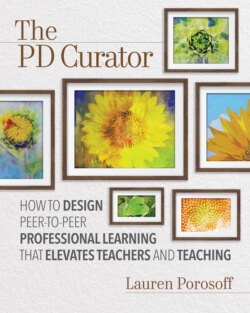Читать книгу The PD Curator - Lauren Porosoff - Страница 8
Building Foundations for Professional Learning
Оглавление. . . . . . . . . . . . . . . . . . . .
When my daughter, Allison, was a toddler, my mother-in-law took us to the Museum of Modern Art in Manhattan. The photos from that outing make Allison look like an art connoisseur as she posed in front of different paintings. But, really, we zipped through the galleries since she had little interest in just looking at the art. I felt bad. We were at one of the greatest museums in the world, with seemingly all the time in the world, to see art that was there for the seeing, and my kid just wanted to go to the café. Still, even with her refusal to "do" the museum, she understood, as a toddler, what "doing" the museum would have meant. That's because the environment was arranged to encourage a very particular set of actions—looking at and lingering over paintings.
Museum curators are experts at arranging environments to influence how people relate to the things on display—and to one another. Art historian Svetlana Alpers (1991) calls that special way of focusing attention "the museum effect—turning all objects into works of art" (p. 26) and catalogs a dizzying number of decisions that exhibition designers make to create the museum effect:
The way a picture or object is hung or placed—its frame or support, its position relative to the viewer (Is it high, low, or on a level? Can it be walked around or not? Can it be touched? Can one sit and view it or must one stand?), the light on it (Does one want constant light? Focused or diffuse? Should one let natural light and dark play on it and let the light change throughout the day and with the seasons?), and the other objects it is placed with and so compared to—all of these affect how we look and what we see. (Alpers, 1991, p. 31)
In other words, designing a museum exhibition is more than just putting art or artifacts on view; it's also about designing an environment that encourages a particular type of viewing.
School environments are not necessarily designed with adult learning in mind. (We might argue they're not even designed with children's learning in mind, but that's a topic for a different book.) No school I've ever visited has a room called "the professional learning center," and I've never seen a teacher's schedule that has a dedicated PD period.
Unlike museums that might devote an entire room to a single object and encourage visitors to spend as much time looking at it as they wish, time and space in schools are scarce. Even if you like the professional learning ideas presented in this book, you won't actually use them if you don't think you're set up to do so. Therefore, before we turn our attention to leading in-house professional learning, let's explore how to make time and space for it.
There's nothing I can do or say that will give you more hours in the day or more square footage in your building. Instead, this chapter will offer ways to help you use the time and space you do have for professional learning.
